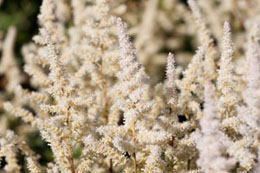Astilbe plants have a glossy, fern-like foliage and beautiful flowers. Mentioned in this article are care instructions for astilbe, that will help you in growing healthy plants...

Astilbe (pronounced as uh-still-bee) is also known as 'false goat's beard', while the astilbe flower meaning is - 'I'll still be waiting'. This plant has compound leaves with panicles of little colorful flowers. There are various varieties of this plant used for gardening. The most common varieties one get to see are the red flower astilbe plants which have medium dark green leaves; other varieties of the plant have whitish flowers, with long, light green leaves, while still other varieties of astilbe give pink-colored flowers. You can either buy the bulbs and plant them to grow the plant, or buy a plant directly. Astilbe bulbs can be ordered online or purchased at a local nursery. With good quality bulbs you can grow plants faster. So, look online for the pictures of astilbe to select the variety which you like the most, and order it online or at a local nursery near you.
Care Instructions
The care instructions for astilbe differs according to the season, so keep in mind these important tips when growing this plant.
Light Requirements: The site for planting these flowering plants should be a dappled shaded area. You can also plant your astilbe in full sun, but make sure you provide them plenty of water.
Soil Requirements: Plant them during spring or fall with a space of 2 feet between the plants. The soil should be humus rich and well drained. Loosen up the soil in the garden bed and add 2 inches of composting layer to it.
Water Requirements: After plantation, provide plenty of water to compact the gardening soil. Keep watering the plants once or twice a week to maintain moist soil, but take care not to over water or make the soil soggy. During rainy season, reduce the amount of water.
Mulching Requirements: Use a mulch of 1 - 2 inches around the soil of the astilbe plant. The mulching should be done after the plantation and watering is done. Mulching helps to preserve moisture which is very important for growing astilbe. To make mulch, use hay and shredded bark mulch. Keep adding more mulch, if you see the thickness of mulch depleting.
Fertilizer Requirements: Provide an all-purpose, slow-releasing fertilizer to the plant. The fertilizer which has an NPK (nitrogen, phosphorus, and potassium) ratio of 3:1:2 ratio is ideal for the plant. The fertilizer should be given to the plants twice a year, during middle of spring and during the summer season. After fertilizing, water the plants thoroughly, and spread the feed evenly.
Pruning Requirements: Pruning can be done by trimming out any dead leaves with sharp shears. If you observe any dry or brown leaves, you can trim the plant to the soil level. Pruning allows the plant to grow healthy foliage, when spring comes. You can remove the deadhead of the astilbe plant for propagation if you need.
Pests: Generally astilbe plants of all varieties are very resistant to any pests or diseases, and rarely you will need to take any pest control measures. But, sometimes the leaves of astilbe will turn brown and start falling off. This happens due to under watering, so make sure you provide the appropriate amount of water to these plants. On certain occasions you might observe white fuzzy growth on the plants which is a fungal infection, prune out such infected leaves.
Following the above care guidelines can help you to grow healthy and happy plants. Astilbe blooms during June. If the plant is taken care of well, you will be rewarded with blooms that will add cheer and color to your garden.






 Astilbe (pronounced as uh-still-bee) is also known as 'false goat's beard', while the astilbe flower meaning is - 'I'll still be waiting'. This plant has compound leaves with panicles of little colorful flowers. There are various varieties of this plant used for gardening. The most common varieties one get to see are the red flower astilbe plants which have medium dark green leaves; other varieties of the plant have whitish flowers, with long, light green leaves, while still other varieties of astilbe give pink-colored flowers. You can either buy the bulbs and plant them to grow the plant, or buy a plant directly. Astilbe bulbs can be ordered online or purchased at a local nursery. With good quality bulbs you can grow plants faster. So, look online for the pictures of astilbe to select the variety which you like the most, and order it online or at a local nursery near you.
Astilbe (pronounced as uh-still-bee) is also known as 'false goat's beard', while the astilbe flower meaning is - 'I'll still be waiting'. This plant has compound leaves with panicles of little colorful flowers. There are various varieties of this plant used for gardening. The most common varieties one get to see are the red flower astilbe plants which have medium dark green leaves; other varieties of the plant have whitish flowers, with long, light green leaves, while still other varieties of astilbe give pink-colored flowers. You can either buy the bulbs and plant them to grow the plant, or buy a plant directly. Astilbe bulbs can be ordered online or purchased at a local nursery. With good quality bulbs you can grow plants faster. So, look online for the pictures of astilbe to select the variety which you like the most, and order it online or at a local nursery near you.